Home » Hunting Dogs » Origins of the German Shorthaired Pointer
Origins of the German Shorthaired Pointer
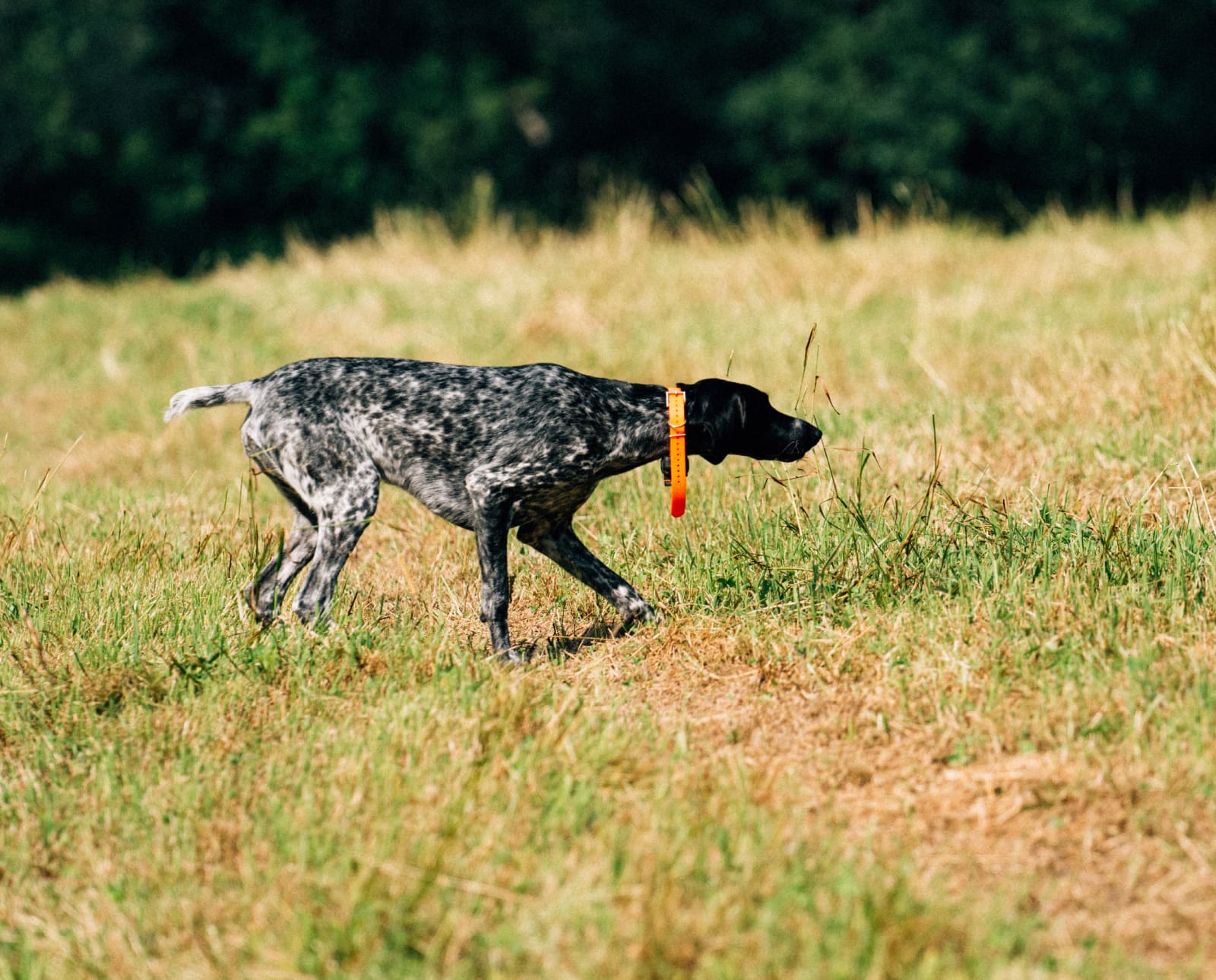
From their home base in Winnipeg, Craig Koshyk and Lisa…
From Spanish Pointers to English Pointers, a dog historian explores the complex history and origins of the German Shorthaired Pointer, the most popular hunting dog breed.
One hundred and fifty years ago, the people of Germany struggled to create a united nation out of a patchwork of tiny kingdoms, city-states, and fiefdoms. Around the same time, german hunters also struggled to create a national breed of short-haired pointing dog. Eventually, both goals were realized.
Listen to more articles on Apple | Spotify
Today, Germany is a rich and united republic and the German Shorthaired Pointer sits in triumph as the most successful continental pointing breed in the world.
The history of the German Shorthaired Pointer
Most histories of the German Shorthaired Pointer begin in the 1870s with a newly unified Germany and a growing middle class of hunters seeking an all-around hunting dog. But the seeds of breed’s creation were sown centuries earlier when pointing dogs from France, Italy, and Spain made their way into the Germanic states and developed into regional varieties of Hühner-Hunde—bird dogs.
Before the turn of the 19th century, pointing dogs were never really bred in large numbers in Germany, nor was there much effort put into improving them for fieldwork. German hunters back then—typically aristocrats with the wealth and authority to hunt—were more interested in hunting big game. They mainly bred tracking dogs and running hounds to pursue deer and boar, but in the mid-1800s the situation began to change. Lightweight, affordable shotguns had become more widely available and, in 1848, the common man had won the right to own them. He had also won the right to hunt. And what he wanted to hunt was everything: fur, feather, small and big game—on land and in the water. So, naturally, the idea of developing an all-around breed of dog that could point, retrieve, track, swim, and dispatch predators began to take hold. There was only one problem: there were no do-it-all dog breeds around back then, and no one knew how to go about creating one.
WATCH: A Deutsch Kurzhaar Story – Bird Dog Trainer for a Day
For one group of breeders, the solution lay in recreating a type of dog that they believed used to exist. It was their “father’s grandfather’s” dog—a solid, old-fashioned German hunting dog capable of all things. They even came up with what, to them, was a foolproof way of doing it. They would select and breed dogs that looked like the “Old Germanic” dogs, and the all-around abilities would automatically follow. Unfortunately, this approach was based on two fatally flawed ideas. First, there never were any ancient all-around German hunting dogs. They existed only in the overheated imaginations of the patriots who promoted them. Fervent nationalism blinded them to the fact that their fathers and grandfathers probably never had hunting dogs of any kind, let alone some kind of wonder-dog capable of all things.
Second, they had somehow managed to get the relationship between a dog’s function and its form completely backward. Selecting dogs with supposedly Germanic ears and Germanic heads did not automatically make them awesome all-around hunting dogs. In fact, in terms of performance, the more the group clung to their misguided beliefs, the worse it got. They ended up with, as one critic called them, “cold-blooded clods,” that lumbered about the field, their heavy bodies and short legs preventing them from moving at anything more than a slow, clumsy trot. Photographs from the period show just how poorly built these experimental beasts were. One, a dog named Feldman I, owned by Prince Albrecht of Solms-Braunfels, looked like he was assembled out of spare parts left over from the creation of the Basset Hound and the Bulldog.
But the breeders adhering to their “form first” idea were led by influential figures such as Karl Brandt. Their main goal was clear: to create a German-looking dog. But in the political context of the time, “German-looking” was code for “not English-looking”. So, if English Pointers had short triangular ears, German dogs must have long rounded ears. If the muzzle of the English dogs had a pronounced stop, then German dogs must have little to no stop, and so on.
Fortunately, more level-headed and pragmatic breeders believed that the best way to develop an all-around gundog was to focus on performance and let appearance take care of itself. Their motto was, “durch Leistung zum Typ,” or, “form follows function.” They believed that the form of a dog must follow its function and that “Germanic” appearance had nothing at all to do with how well a dog could hunt. They even dispensed with much of the nationalistic bombast of their counterparts and crossed their dogs with English Pointers and Setters to gain speed, range, and nose. Eventually, these breeders won the day. Their dogs proved to be superior in every way to the dogs bred by the “form first” group.
In 1879, a standard for the German Shorthaired Pointer was agreed upon and, in 1880, a breed club was formed. Originally called the Brauntigerklubs in reference to the breed’s brown and white roan “tiger” coat, the following year it was renamed Klub Kurzhaar. Shortly thereafter, in 1897, the club began holding hunt tests and established its first studbook. Growth for the GSP was steady throughout the early 1900s, and, by the 1930s, overall breed type had been firmly established and the long-sought-after all-around abilities finally secured.
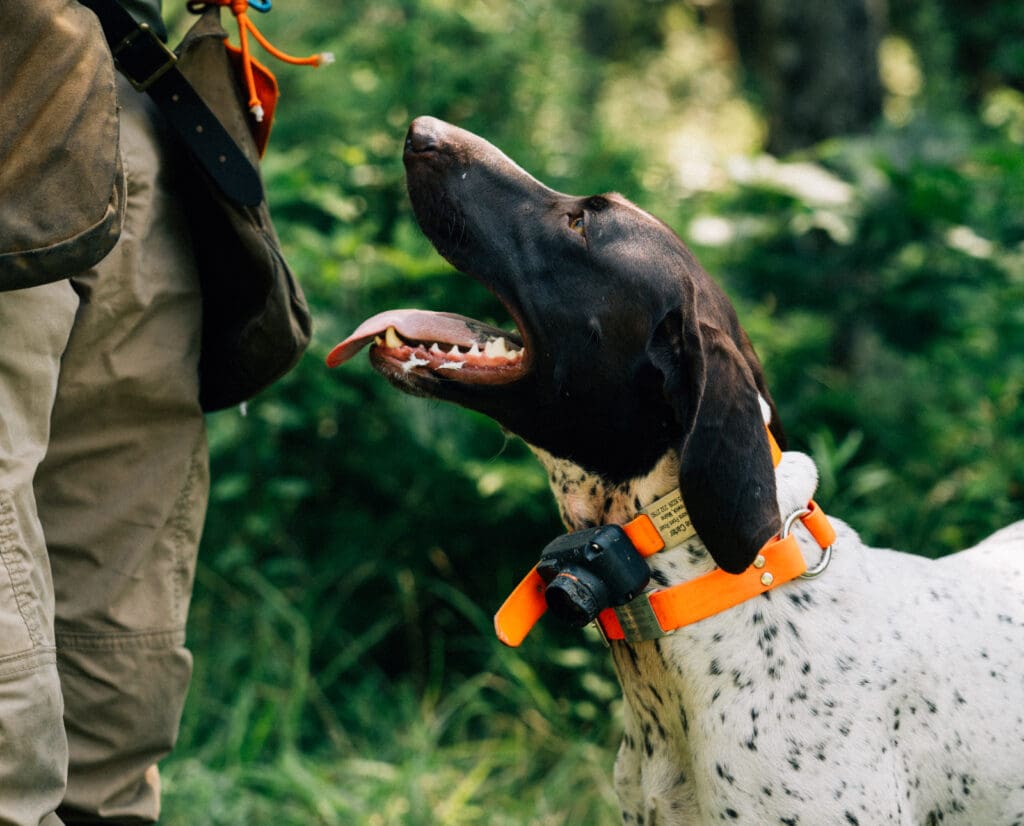
German Shorthaired Pointers and the North American connection
It was around this time, just before World War 2, that the GSP began to appear in North America. Dr. Charles K. Thornton of Montana is usually credited with establishing the breed in the United States in the 1920s and 30s. However, it is known that several GSPs had already made their way to the country, most likely with families emigrating from Germany.
With the onset of the Second World War, imports of German-bred dogs to the U.S. ceased. During the conflict, the GSP, like all the other breeds, suffered terribly. By 1945, it was in rough shape. Many breeders had been killed or displaced and their lines destroyed or reduced to very few individuals. During the first few years of Allied occupation, tests and trials were not permitted and hunting was strictly forbidden. Even meetings among breeders and breed supporters were difficult to arrange. Undaunted, breeders continued to pursue their efforts, and by 1949 were once again testing their dogs in the field.
READ: German Shorthaired Pointers for Waterfowl Hunting
The 1950s and 60s were years of rapid expansion for the breed in Germany and throughout much of the rest of the world. In the U.S., in particular, the breed’s popularity grew by leaps and bounds as more and more hunters and field trailers discovered its qualities. By the 1970s, the GSP had become one of the most popular hunting dogs in North America and much of Europe. It remains so to this day.
The Spanish Pointer connection to German Shorthaired Pointers
No one knows the exact mixture of raw material that was used to create the GSP, but most authorities believe that the Spanish Pointer played an important role in the early days. Considering the geography and history of the region, this idea would seem to make sense. After all, Germanic and Hispanic cultures have had close contact for centuries, so there would have been ample opportunity for Spanish dogs to reach Germany. But the same thing could be said about Italian, French, and English dogs—they could have made their way to Germany just as easily. To prove a direct connection between German and Spanish dogs, we need more than just guesswork.
Searching the available literature, I found that most English sources naturally focus on the role Spanish dogs played in the development of the British pointing breeds. German sources were not much help either. They tend to be rather vague, often just referring to dogs “from the Mediterranean area.” French and Italian sources frequently mention the possible connections between their dogs and the GSP, but hardly ever mention Spanish or English Pointers. An excellent example is from the book
Il Cane by Angelo Vecchio, published in 1897. According to Vecchio, the GSP was simply:
“…another beautiful degenerate son of the great Italian Bracco! that our German friends don’t hear me, otherwise who knows what kind of trouble I would be in. But let’s just say that the general form of the German Pointer is an imperfect reproduction of our Bracco Lombardo” (Angelo Vecchio, Il Cane, quoted by Claudio De Giuliani, L’ Enciclopedia dei Bracchi, 23-24)
It wasn’t until I learned to read Spanish that I found clear indications that Spanish pointing dogs probably did make their way directly from Spain to Germany. Among the most detailed accounts are those found in an article written by José Manuel Sanz Timón, a veterinarian geneticist who has spent much of his life studying Spanish dog breeds and who was instrumental in the restoration of the Burgos Pointer. He wrote:
“...the oldest description of the that we know of is from a German officer of the Legion Guelfa, better known as “The King’s German Legion”…a body of mercenaries in the service of the British crown. … Captain Schwertfeger in Hanover, in his book Geschichte der Deutschen Legion Königlich 1907, also cites this breed of dogs as gifts and presents from the patriots in the lands of Burgos and provides this brief description: Strong of body and head, white and brown spots and freckles….These individuals were transferred to Germany and shortly thereafter gave rise to the breed known as the Württemberg Pointer, which was a major input for the genetic selection of the current German Shorthaired Pointer” (José Manuel Sanz Timón, El Perro Perdiguero Burgalés, quoted by Ángel Martíñez Ibáñez, El Perdiguero de Burgos, 34).
In 2008, I traveled to Spain to photograph Burgos Pointers. My first impression of the dogs was that they do resemble the photos I had seen of early GSPs. When I asked their breeders about the similarities, they mentioned that there have been crosses of GSPs into lines of Burgos Pointers in the last 20 years, so that might explain some of the similarities. But they also said that the Burgos Pointer was used to refresh GSP lines many years before that, around the time of the Spanish Civil War in the 1930s.
Searching for documentation to support these claims, I consulted an excellent book about the Burgos Pointer written by Ángel Martíñez Ibáñez. In it, I found the following eyewitness account presented by José Manuel Sanz Timón:
“The Civil War was a time when many individuals of the breed were taken, at ridiculous prices, to Germany. The Condor Legion took planes full of dogs to Central Europe. This event—obviously difficult for the Germans to admit—is true, and there is an exceptional witness. The current colonel, Don Raúl García Bengoechea, who was assigned to the capital of the national zone at that time, personally saw how this emigration was carried out. They bought adult females, pregnant females, and puppies, as well as males. One cannot say how many dogs the Germans took, but it is assumed that it was many—and the best” (José Manuel Sanz Timón, El Perro Perdiguero Burgalés, quoted in Ángel Martíñez Ibáñez, El Perdiguero de Burgos, 51).
So it seems there is very good evidence that at least one breed of Spanish pointing dog, the Burgos, did go to Germany in the 1930s. Others must have preceded it in the 18th and 19th centuries. But exactly how much of a role any breed of Spanish pointing dog played in the development of the GSP is, of course, open to speculation.
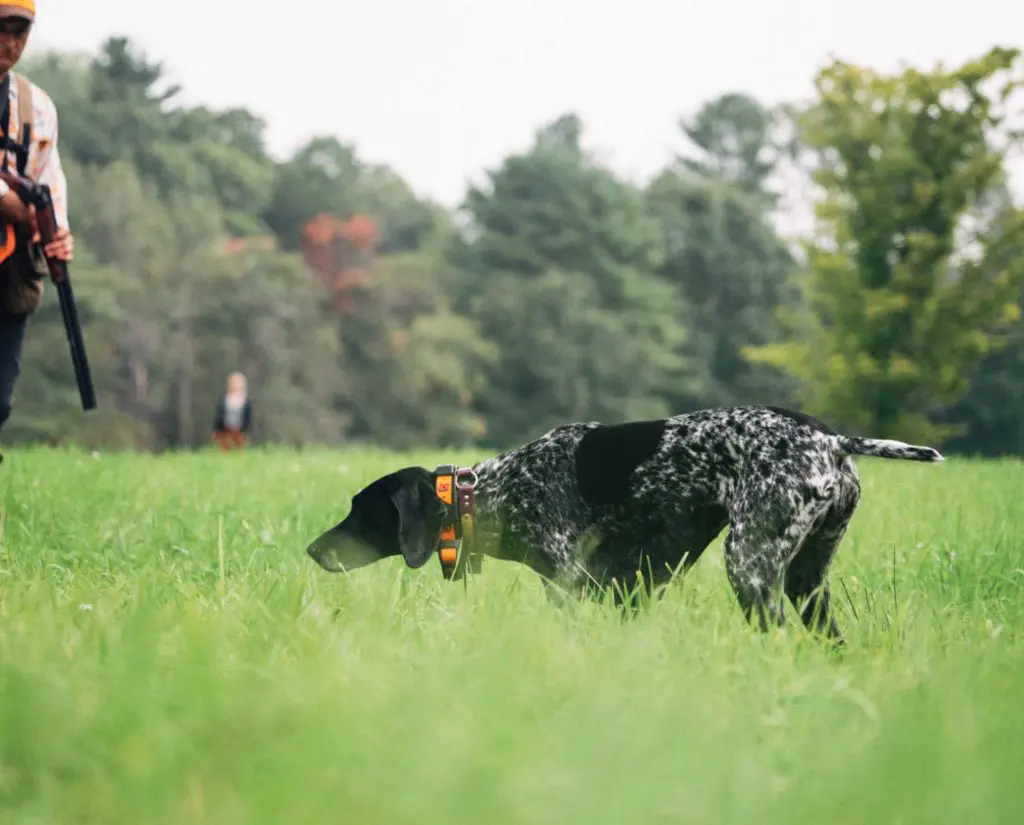
Arkwright Pointers and their connection to German Shorthaired Pointers
Another breed often referred to in the history of the GSP is the so-called Arkwright Pointer. It is usually credited with bringing in a high nose, a solid point, and, most significantly, the black coat. Curiously, the term “Arkwright Pointer” only seems to appear in GSP histories. I have found no mention of it in histories of the English Pointer. William Arkwright never called his dogs “Arkwright Pointers”—to him, they were English Pointers with black coats. They had been around for a long time before he began to breed them, and he considered them to be among the purest strains.
So why did the Germans call them Arkwright Pointers? I suspect that it was a matter of political correctness. To avoid using the term English Pointer, they came up with something a little more palatable. A similar situation occurred around the time of the First World War when anti-German feelings were running high in the United States and United Kingdom—the name of the German Shepherd Dog was changed to “Alsatian.”
With the tremendous success the breed has had in field trials in the U.S., France, Italy, Spain, and elsewhere, accusations of more recent crossbreeding have been made for decades. The most common “culprit” of these allegations is the English Pointer. Some believe that many dogs registered as German Shorthaired Pointers are now about as German as an order of fish and chips. When I’ve discussed these accusations with breeders in Europe and North America, I’ve received answers ranging from vehement denials to sly nods and winks. So far no one has admitted anything publicly, nor has any GSP club officially sanctioned any sort of program to infuse outside blood. Nevertheless, it is reasonable to assume that crossbreeding has occurred in some areas in the last half-century. But just as some of the changes seen in the breed are almost certainly due to the Pointer influence, many are due to highly focused selective breeding done by people trying to build a better mousetrap for different outdoor pursuits, terrains, and types of game.
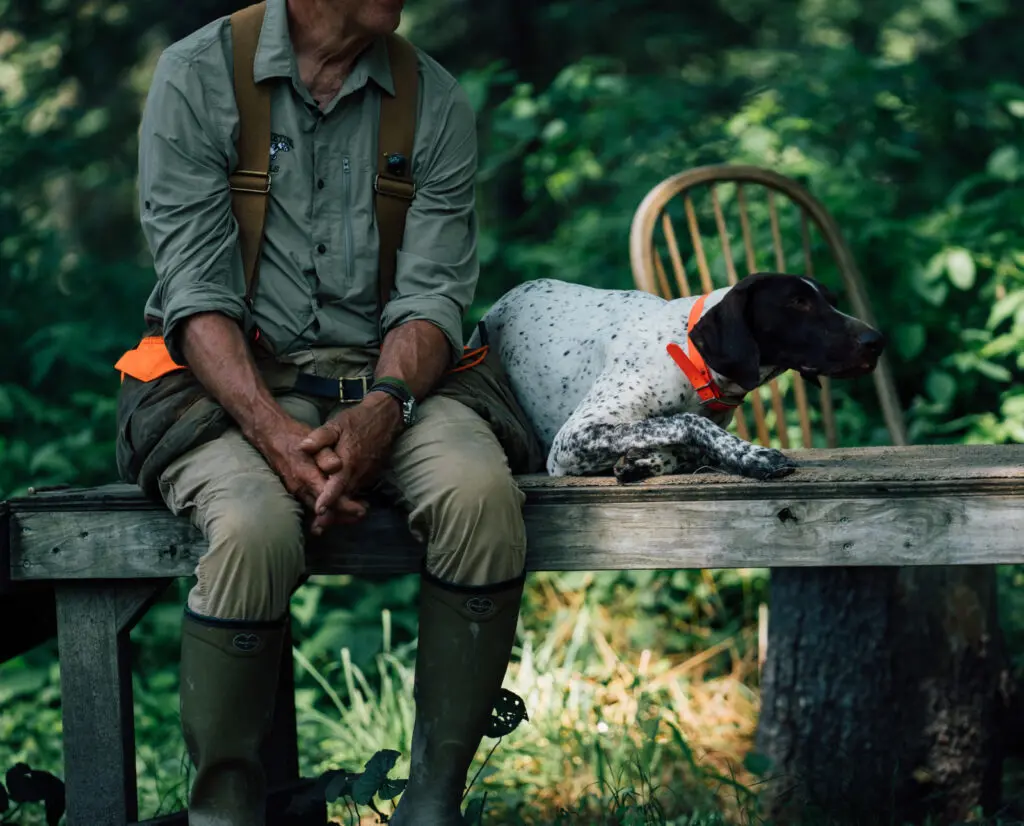
Craig Koshyk’s take on German Shorthaired Pointers
It is often said that the German Shorthaired Pointer is the most popular versatile breed in the world. My travels seem to confirm its No. 1 position. I’ve seen GSPs in Saskatchewan and Slovakia, Arizona and Austria, and a dozen other places in between. I’ve seen the wide variety of types within the breed, from traditional utility dogs in Germany, to “little white rockets” in Canada and the U.S., but when it came time to write my views on the breed, one very special dog—from right here in Manitoba—came to mind.
His name was Willy. He was prairie-bred and built like a pickup truck. In his prime, he was one of the best sharptail and pheasant dogs I’d ever seen. But as he got older, the many miles of northern prairie he’d covered began to catch up with him. At 14, he was nearly deaf and blind, but he was still able to hobble around his owner’s yard where members of our small pointing dog club would occasionally meet for informal training sessions.
One day, as we were working young dogs on planted pigeons, Willy lay on the grass snoring under the warm summer sun. Out in the field, about 50 yards away, a pup was on point. A handler walked up, flushed the planted bird, and fired a blank. At the sound of the gun, Willy woke with a start. He struggled to his shaky legs and made a wobbly beeline to the field. It took him a while to cover the 50 yards, but once he was there, he made a short cast to the left, another to the right, and found the scent cone. Then, like an ultra-slow motion scene right out of The Matrix, he eased into a picture-perfect point.
I have no idea how many hundreds, or even thousands, of points Willy had made during his lifetime, but standing there that day, I knew I was seeing his last. As his owner took him by the collar and gently led him away, a fist-sized lump formed in my throat. By summer’s end, Willy had passed away. A proper gravestone now marks his final resting place near the training field.
To me, and I suspect to many others who had the pleasure of hunting with him, Willy embodied the very essence of his breed: a handsome hunting dog, a brave, loyal companion as honest and strong as the day is long.
From their home base in Winnipeg, Craig Koshyk and Lisa Trottier travel all over hunting everything from snipe, woodcock to grouse, geese and pheasants. In the 1990s they began a quest to research, photograph, and hunt over all of the pointing breeds from continental Europe and published Pointing Dogs, Volume One: The Continentals. The follow-up to the first volume, Pointing Dogs, Volume Two, the British and Irish Breeds, is slated for release in 2020.



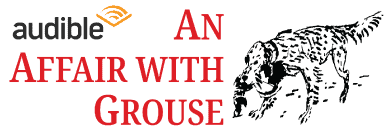
Great article Craig with lots of insight. One part though with regards to Arkwright Pointers (Prussia Pointers from the wars) was the cross breeding happened mainly around 1907. The main reason for the cross (written in the German club breeder notes) was for PIGMENT only. The original Klub Kurzhaar lines started to become lighter pigment colors. Also, the crossings weren’t accepted into their stud books until the early 1930s prion to Charles Thornton’s imports. In the 1910-20s they had two sets of stud books to separate the Prussian Pointers. They realized by the late 20s that intercrossings reached most of the originals (a litter with black and Braun pups where the braun pups bred into other lines) bloodlines that they were finally accepted into one. Ironically, Charles and C. Bede Maxwell had no interest in importing black DKs. Most likely the breeders they spoke to talked them down or other reasons (hence the AKC black color not accepted). The separate stud book for the crossed Prussia pointer lines gives strong indication that “Burgo” pointers were never crossed and just enjoyed as prizes. I firmly believe the 18 & 19th centuries the Spanish pointer was crossed. One last thing to note is the GSP name with “pointer” is not used. Prior to 1870s there are writings of “German Pointers” and “German Utility Hund” names. However the DK name was set it stone with the breed club Klub Kurzhaar as Deutsch Kurzhaar. Charles wanted to market the GSP with Americans by naming it the German Shorthair Pointer-Retreiver! However, the AKC rejected his application and the GSP name was relegated into just a pointing breed instead of something versatile-special. The AKC then marketed as the GSP with the CKC and then the UKC.
Thanks for the kind words and additional information, very interesting. Here is something else one might want to consider when reviewing the breed at the time..
The creators of the Kurzhaar were working well before the modern field of gentics was developed. So naturally, they very often struggled to understand and predict the results of their efforts. And some of the most vexing problems they had to overcome were related to their dog’s coats. So while the Pudelpointer and Drahthaar people were trying to deal with the hard-to-stabilize wirehaired coat, other breeds like the Kurzhaar and Weimaraner were struggling to stabilize the colour of their breeds’ coat (and the length of coat as well. Both breeds had the occasional longhaired pup pop up here and there but Kurzhaar folks worked to eliminate it completely, Weim folks eventually agreed to accept it.)
So at the time, the Kurzhaar folks had to figure out how to sovel the problem of what they called “pigment”. But in my view, it may not have all been because the orthodox brown “tiger” coats were starting to become lighter shades of brown (something I have not come across happenin in any other brown breed). It may have had more to do with the fact that coats were showing up in different brown-related or brown-adjascent colours like a dilute ‘silver’ brown or “lemon” (orange) or coats with tan points and other markings that were thought to be from hounds.
How do we know this? Well, if you look at Kurzhaar studbooks from the early 1900s, you will see Weimaraners registered as “silver” Kurzhaars, and writings from the time show that there was an effort to register Wurtemburger Pointers (a tri-colour shorthaired pointer from southern Germany) in the same studbook. And there are also references to Kurzhaars with ‘gelber brand’ markings, lighter sandy coloured markings on the cheeks.
And we know that like all the other folks working to create german pointing dogs at the time, the Kurzhaar folks were trying to figure out just what kind of coat their dogs should have. The first decision was easy..it should be short. Period, end of story. 99% of all shorthaired breeds did the same thing. The exception was the Weim as mentioned above. They finally accepted the Longhaired variety in the 1930s.
The second decision was what coat colour(s) should be accepted. But that was harder than just choosing between short or long coats because coat colour genetics are more complicated. So you can imagine the frustration of folks who wanted to breed dogs with the brown “tiger” coat seeing dogs with silver, or tri-colour or lemon coats pop up in litters. Today we could take care of that in a generation or two with simple DNA tests or even close readings of pedigrees. We know what colours are dominant and which are recessive and we know how to avoid them or get them when selecting breeding pairs. But back then, they didn’t have any such knowledge. So they used the tools they had, or thought they had.
So, if all the ‘off’ colours silver, tri and orange are lighter than the colour you want, and often come with lighter lips, nose and eye colours, you blame it on a lack of “pigment”. And what is the solution for a lack of pigment? If you are a painter, you add a bit of black, if you are a dog breeder you breed to a black dog. Makes perfect sense….if you don’t have any knowledge of genetics.
But when they did that, what did they get? Black pups. But when they then bred the pups to other brown pups, some of the next generation had brown coats. But did those brown coats have more pigment because one parent was black? I doubt it, but would have to ask a genetics expert to be sure. All I know is that no other breed of dog with a brown coat at that time had similar problems with “pigment”. Braques Francais, Bracco Italiano, French Spaniels etc. etc. never tried to darken the coat by breeding to black dogs. In fact if/when they did breed to black dogs (mainly pointers and setters) they spun off a new and different black and white breed (braque d’auvergne, epagneul blue de picardy).
In any case, I am rambling now… no surprise!
Bottom line: when we read the old accounts we need to consider the state of the art of breeding of the time and the context in which things were written. I think that we can all agree that at least some German breeders chose to breed to black Pointers from England to get more pigment in their line. But we need to understand what they meant by pigment and what the exact nature of the problem was that they were trying to solve.
I am confused on your timeline Craig. I see you have your wars mixed up with the Burgos and it’s breed going to Germany. The Burgos was exported in the Spanish civil war which was in 1893. Not just the American/Spanish war in 1930. The German’s did in fact use the Burgos to breed into the German hunting breed dogs. But far earlier then you may believe.
Thanks for the comment Chris. My references to Spain in the chapter on the GSP are based on information gathered from Spanish sources and publications as well as a few mentions in German sources and archives. So any dates given refer to wars on the continent of Europe and not, for example, to the Spanish-American war, (April to August 1898) that was fought in the Caribbean and the Pacific and did not involve Germany. The Spanish Civil War I refer to occurred in Spain from 1936 to 1939 and involved large numbers of German troops (mainly Luftwaffe).
I am too lazy to go into a ton more detail about it here, so I will cut and paste a relevant section from the Burgos chapter in my book:
It is tempting to conclude that the Burgos Pointer is the granddaddy of all pointing dogs. After all, it looks like an old breed, it comes from the very region where all pointing dogs originated, and it is even called “Old Spanish Pointer” in some publications. However, according to veterinary geneticist and breed expert José manuel Sanz Timón, the Burgos Pointer is a relatively modern descendant of the Old Spanish Pointer that is so often referred to in the old literature.
Sanz Timón points out that all too often, people simply assume that any historic mention of a Spanish Pointer automatically means it was from Burgos, or that any painting that includes the image of a hunting dog represents a Burgos Pointer. He suggests that it is “patriotic enthusiasm” that has caused breed supporters to claim that the Burgos is the original pointing dog.
According to Sanz Timón, the first time that words Perdiguero and Burgos were mentioned in the same sentence was sometime after 1808. He writes that an inventory drawn up by an official of the King’s German Legion includes a list of supplies and materials that were to be shipped out. On the list, it is said, is mention of dogs that “are called Perdigueros in Burgos”. He also cites another reference to the breed in the 1907 book, Geschichte der Königlich Deutschen Legion (History of the King’s German Legion), in which author Bernhard Schwertfeger writes about large brown and white dogs from the area of Burgos that were given as gifts. Based on these and other documents, Sanz Timón concludes that the region of Burgos has only recently been associated with a specific type of pointing dog. If the Burgos Pointer were the original Spanish Pointer, there would be much earlier references to it by name. Furthermore, the Burgos Pointer has a white and brown coat while many of the early English references to the Old Spanish Pointer indicate that it was often black, or even tri-colored.
In Spain there are remarkably few references to any kind of generic, widely distributed pointing dog. But there are mentions of local varieties that went by names such as Pachón de Navarra, Pachón de Vitoria, Perdiguero Navarro, Perdiguero Leonés, Perdiguero Gallego, Perdiguero Portugués, Ca Mè Mallorquí and Gorgas. In some cases, these local varieties differed in name only. In other cases, the dogs were clearly different in size, shape, coat or other important aspects. The largest contributing factor to these differences was the ratio of blood from the original types of dogs used to create them: the Sabuesos, a type of tracking dog, and Pachónes, the earliest type of pointing dogs.
No matter what the name or variety, all the local varieties of Old Spanish Pointers were already in decline when William Arkwright traveled to Spain in the 1890s to research the history of the English Pointer. Since he makes no mention of any type of dog from Burgos, it is assumed that the breed now known as the Pediguero de Burgos represents a comparatively recent branch of the Old Spanish Pointer that developed in the relative isolation of the Burgos region.
In modern times, we find references to the breed in 1912 when the first two Perdigueros were registered with the newly founded Real Sociedad Central de Fomento de las Razas Caninas en España, the Royal Spanish Canine Society. The pedigree record indicates that during this time breeders were practicing either extremely tight inbreeding or they were crossing to other breeds. As a result, there was very little uniformity in the breed. In fact, until the 1950s, there wasn’t even an official standard for the Burgos Pointer.
The civil war that engulfed Spain in the 1930s had dire consequences for all dog breeds in Spain. For the Burgos Pointer, there was the added difficulty that many of them were taken out of Spain by German soldiers stationed there as “volunteers” and advisors. Members of the so-called Condor Legion are said to have purchased many Burgos for shipment back to Germany and there are several eyewitness accounts of planes being loaded with large numbers of adult dogs and pups.
In a symposium on Spanish dog breeds held in 1982, José Manuel Sanz Timón presented an account from a Spanish military officer. Don Raúl García Bengoechea, who was assigned to the capital of the national zone at that time, personally saw how this emigration was carried out.
“They bought adult females, pregnant (females) and puppies, as well as males. One can not say how many dogs the Germans took, but it is assumed that it was many and the best. The war was a hard blow to the breed.”
By the end of the civil war, there were very few Burgos Pointers left in Spain. Those that remained were very heavily inbred and inbreeding depression became a serious issue. By the late 1960s only a dozen or so Burgos Pointers were registered each year with the Spanish Canine Society and articles with titles such as “Farewell Burgos Pointer” began to appear in the Spanish sporting magazines.
More about the Burgos here: http://dogwilling.ca/pointing-dog-blog/2011/08/breed-of-week-burgos-pointer_30.html
Craig Koshyk. You do understand that Perdiguero de Burgos in the Spanish definition. Actually means retriever of Burgos right?!? Although the Burgos is a natural pointer and versatile breed. They are actually a retriever by name of definition!!! There is a book that was written in the 1700’s. Called History of Geography written by Barnabas Simonds. One you should read. Another question you should ask all the German clubs. Is why is there a picture of the German Nazi posing with a Burgos. That hangs in Berlin Germany? As the Germans viewed the Burgos pure. I do have the picture of it if you would like?
Thank you for your comment. And yes, I know that if you type the Spanish words “Perdiguero de Burgos” into Google Translate, it comes out as “Burgos retriever.” But that translation is wrong, sort of. Let me explain:
Perdiguero is made up of two parts: “perdi”, from the Latin word perdix (from the greek πέρδικα), which means ‘partridge’ and the suffix ‘ero’ (Latin ‘arius’, English ‘arian’) which means “pertaining to” or ‘related to’ (for example, a person who works in a library is a librarian). So a literal translation of the term would be “someone or something that does something related to partridges.
In old sporting literature, authors used the Spanish word perdiguero and its Portuguese equivalent, ‘perdigueiro,’ to describe a certain type of hunting dog found across much of Europe. Other Spanish terms like Braco, Perro de Punta, and Perro de Muestra were also used for the same type of dog. All of those terms refer to dogs that hunted partridges by pointing them.
Did some of those dogs retrieve? Absolutely! But the word perdiguero in the context of hunting dogs does NOT mean retriever. It means pointing dog.
So why does Google Translate say it means ‘retriever’? Well, because it does mean ’retriever’ (sort of), but in a completely different context.
If you look up the word in major Spanish dictionaries, you will find the ‘partridge dog’ definition first and then another definition after it. The second definition pertains to a person who purchases game (like partridges) from hunters to then sell at the market. Take a look at this entry in a Spanish dictionary
(Diccionario general etimológico de la lengua española published in 1889)
Perdiguero:
1. Adjetivo que se aplica al perro u otro animal que caza perdices.
2. El recovero que compra de los cazadores la caza para revenderla.
If we run that through Google Translate we get.
Perdiguero:
1. Adjective applied to a dog or other animal that hunts partridges.
2. The retriever who buys game from hunters to resell it.
Notice how, in the context of a person who buys game, the word “recovero” is translated as ‘retriever’? I am not sure why. All my Spanish/English dictionaries translate “recovero” as “poultry dealer”. But maybe it is because recovero is sort of related to the term ‘cobrador’, which actually means ‘retriever’ when it comes to dogs. After all, the Golden Retriever is COBRADOR DORADO in Spanish.
Anyway, thanks for the comment. It motivated me to dig into some of my old notes and revisit some cool dictionaries and old manuscripts.
As for German soldiers posing with Perdiguero de Burgos, I can only point you to the work of Spanish veterinarian and geneticist José Manuel Sanz Timón, who wrote a book about the breed and mentions the Spanish/German connection several times. He also wrote about it on his club’s website here https://www.perdiguerodeburgos.es/index.php/raza/el-perdiguero-en-la-historia/39-origenes-e-historia-antigua-hasta-1911
The Persian spitz was bred into the DK’s as a foundation breed because it fearlessness and sharpness as written. Not the Persian grey or Saluki. So let’s not get that confused in the matter.
Great article. The last story almost brought tears. I have had the privilege of hunting wild Texas quail in the quail “good old days” as well as many upland Montana hunts and have had GSP’s for 30 years. All great pets and great hunting dogs. My biggest runners and best dogs all had a good deal of white in their coats. I am just fine with that regardless of the influence of English pointers (which are great dogs as well)!
I had the privilege of owning, training, and hunting with a GSP named Wilhiem (Willy) for 14 years also. He was easily the best and most loyal dog I ever hunted over. Had an aggressive form of lymphatic cancer not taken him in his 14th spring he physically would have been able to continue hunting longer. I am of the belief that one only gets such a special relationship once in a lifetime and Willy was it.
I bought a GSP female from a family who lived in Medford, NJ. There dogs were from the Graubinbuk kennels. I am not sure but I think Austria. Here name was Gretchen von zdon. She was what I wanted an all around gun dog. Steady to wing and shot, retriever. I hunted her on everything from grouse, ducks woodcock and all upland game. She died in her early 8 yr of life of bone cancer.. Never will I ever replace her. A once in a lifetime dog.